Yes!
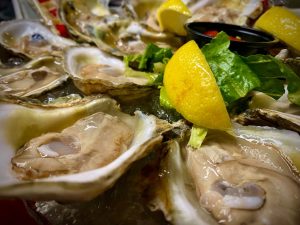
For our charter guest from out of town, we often asked about Chesapeake Bay oysters: when is the best time to eat them? The answer is, always!
While oysters are available year-round, their flavor profiles change with the seasons – so some degree it’s up to your personal preference. The old adage about only eating oysters in months with “r” has some truth to it – oysters tend to be plumper and sweeter during cooler months (September through April) when they’re storing glycogen for winter. Less truth is, if the oyster is fresh kept cold and serve properly their fantastic year-round!
Oysters have long been celebrated as nature’s perfect bite of the sea, and nowhere is this truer than in the Chesapeake Bay. As a cornerstone of the region’s culinary heritage, Chesapeake oysters are renowned for their distinct characteristics and complex rating system that helps consumers understand exactly what they’re getting.
The Chesapeake Bay Rating System
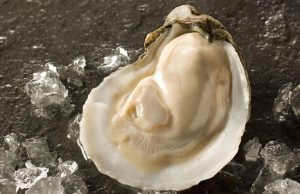
Chesapeake Bay oysters are primarily rated on three key characteristics:
Salinity: Measured on a scale of 1-5, with 5 being the saltiest. The salinity level depends largely on where in the Bay the oysters are harvested. Those closer to the Atlantic Ocean typically score higher on the salinity scale, while those further up the Bay tend to be milder.
Size: Chesapeake oysters are categorized by their shell length:
- Standards: 3 inches
- Selects: 3-4 inches
- Counts: 4+ inches
- Mediums: 2.5-3 inches
- Small: Under 2.5 inches
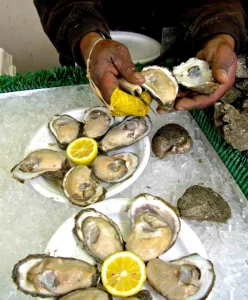
Meat Quality: This is rated as either Choice, Standard, or Commercial, based on factors like fullness, color, and texture of the meat.
Understanding Your Oyster’s Origin
The Bay is divided into distinct growing regions, each producing oysters with unique flavor profiles:
- The Lower Bay: These oysters tend to have the highest salinity ratings (4-5) and often feature crisp, clean finishes with mineral notes. Popular varieties from this region include Mobjack Bay and York River oysters.
- The Mid Bay: Here you’ll find moderate salinity ratings (2-3) and a perfect balance of sweet and briny flavors. Favorites include Rappahannock River oysters.
- The Upper Bay: These oysters typically have the lowest salinity (1-2) but often showcase complex butter and mushroom notes that make them perfect for cooking.
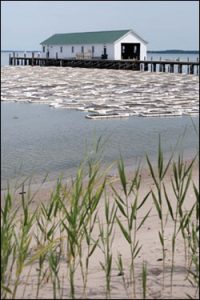
While Chesapeake Bay oysters faced significant challenges in the late 20th century due to overharvesting and disease, recent conservation efforts and aquaculture innovations have led to a remarkable comeback. The large percentage of oysters are actually farmed. It’s a burgeoning business. Today’s oyster farmers combine traditional knowledge with modern techniques to produce some of the finest oysters on the East Coast.
How Each Oyster Tells Its Story
Just as wine connoisseurs speak of terroir, oyster aficionados understand that each Chesapeake Bay oyster is a living record of its environment. The story begins with the water itself – the unique mix of freshwater flowing down from the Susquehanna River meeting the salty Atlantic tides creates distinct zones of salinity throughout the Bay’s 200-mile length.
The mineral content of the local creek beds, the type of food algae flourishing in different sections of the Bay, and even the seasonal rainfall patterns all contribute to an oyster’s distinctive character. A Rappahannock River oyster might develop sweet, buttery notes from feeding on the rich plankton blooms of its home waters, while an oyster from the mouth of the Bay near Virginia Beach might acquire an intense brininess that speaks of its ocean-influenced environment.
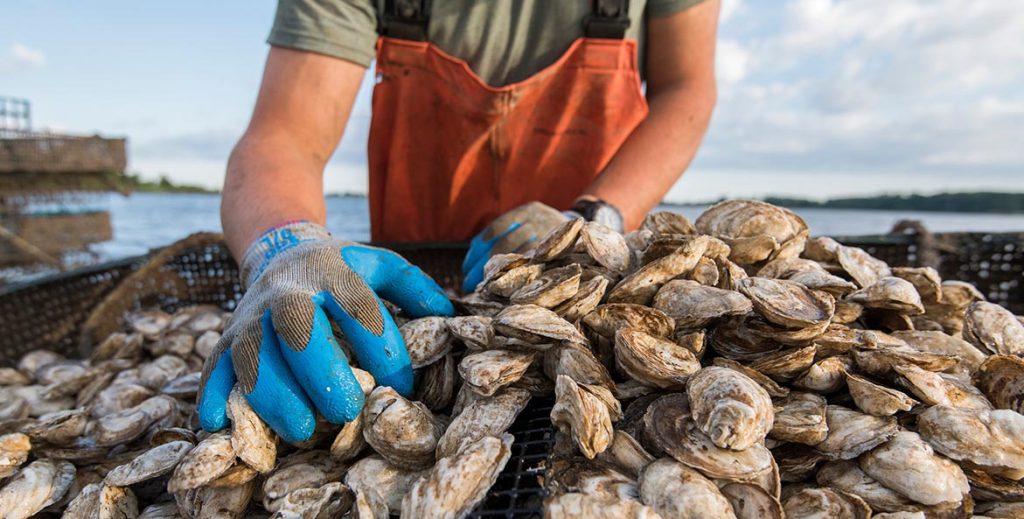
The watermen of the Chesapeake, many from families who have worked these waters for generations, know their territories intimately. They understand how the bottom composition – whether muddy, sandy, or rocky – affects shell development and meat quality. They can tell you how an unusually warm winter might alter an oyster’s glycogen levels, making it less sweet, or how a particularly rainy spring might decrease salinity levels in their harvest areas.
This deep connection between place, process, and product is why Chesapeake Bay oysters, like fine wines, often carry the names of their source waters – names like Chincoteague, Tangier Sound, or Fishing Bay. Each name promises a specific flavor profile, a particular mix of minerality, salinity, and sweetness that speaks of its origin.
Understanding these nuances through the rating system allows consumers to not just eat an oyster, but to taste the story of a specific place in the Chesapeake Bay, maintained by the careful work of local watermen who serve as both harvesters and stewards of this remarkable ecosystem.
America’s Oyster Regions: A Coast-to-Coast Comparison
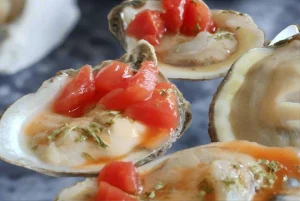
While Chesapeake Bay oysters are legendary, each of America’s coastal regions produces oysters with distinct characteristics that reflect their unique environments. Pacific Northwest oysters from Washington and Oregon, like the famous Kumamotos and Olympias, tend to be smaller and sweeter than their Chesapeake cousins, with pronounced cucumber and melon notes. These Pacific varieties often score lower on the salinity scale (typically 2-3) compared to Chesapeake specimens, but they make up for it with a complex mineral finish that comes from the cold, nutrient-rich waters of the Pacific.
New England oysters, particularly those from Cape Cod and Maine’s Damariscotta River, typically present a higher salinity profile (often 4-5) than even the Lower Chesapeake varieties. These Northern oysters tend to be firmer and crisper, with clean, sharp finishes that lack the buttery undertones characteristic of Chesapeake Bay oysters. The cold Atlantic waters produce slower-growing oysters with deeply cupped shells and intense ocean flavors.
Gulf Coast oysters, particularly those from Louisiana and Texas, offer yet another profile. These warm-water oysters tend to be larger and meatier than their Chesapeake counterparts, though they generally score lower on the complexity scale. While Gulf oysters may not match the nuanced flavor profiles of Chesapeake varieties, they excel in applications like char-grilling and deep-frying, where their plump, mild meat holds up well to heat.
What sets Chesapeake Bay oysters apart in this national comparison is their remarkable range of flavor profiles within a single body of water. While other regions might specialize in particular characteristics, the Chesapeake’s unique geography – stretching from the salty Atlantic to the freshwater tributaries – allows it to produce everything from intensely briny specimens to subtle, sweet varieties all within its waters. This diversity, combined with centuries of harvesting tradition and modern aquaculture techniques, makes the Chesapeake Bay a uniquely complete oyster-producing region.
Island Chill Yacht Charters
By request, we get oysters from several suppliers, but we favor the ones bought about a mile away and brought to shore by the boat about 50 yards away from our dock. We know the fisherman very well and he always gets us fresh, local and excellent. Feel free to give us a call and we’ll arrange oysters on your charter!
